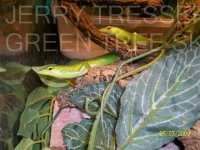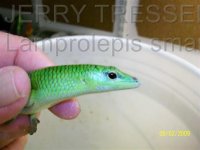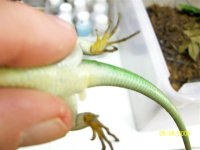Thought I would share some photos of my group of Lamprolepis smaragdina, or commonly called Gree Tree Skinks... These are in excellent condition, great eaters, and love the sun... Hopefully I may get some eggs.. They can drop 2 at a time. Gestation period about 55 days... Enjoy. JERRY
You are using an out of date browser. It may not display this or other websites correctly.
You should upgrade or use an alternative browser.
You should upgrade or use an alternative browser.
Green Tree Skinks
- Thread starter FLYGUY
- Start date
Mikhail F. Bagaturov
New member
Hi Jerry!
They are indeed great species.
Do you knew they need a high insolation? Thus reptiglo 3. and up is a must together with the high temp spot around 30-32 Celsius grades.
They also like dence vegetation in enclosure and high level of humidity.
Rather nervous they anyway is a great display animals, bred well in captivity.
Several years ago i kept and bred both forms of this species - entire green like yours, which is common around the hobby and other half green-half brownish-olive which is more nice as green color is something like of the color of the marine green.
They are indeed great species.
Do you knew they need a high insolation? Thus reptiglo 3. and up is a must together with the high temp spot around 30-32 Celsius grades.
They also like dence vegetation in enclosure and high level of humidity.
Rather nervous they anyway is a great display animals, bred well in captivity.
Several years ago i kept and bred both forms of this species - entire green like yours, which is common around the hobby and other half green-half brownish-olive which is more nice as green color is something like of the color of the marine green.
Last edited:
They are quite interesting
and you are right, they immediately hide once they hear you or see you... Some have acclimated themselves, but most are very secretive... They love to bask in the sun..
The other species that you mentioned is Dasia olivacea. I had those, but there is no comparison. Those were called Emerald Green Tree skinks... JERRY
and you are right, they immediately hide once they hear you or see you... Some have acclimated themselves, but most are very secretive... They love to bask in the sun..
The other species that you mentioned is Dasia olivacea. I had those, but there is no comparison. Those were called Emerald Green Tree skinks... JERRY
Mikhail F. Bagaturov
New member
The other species that you mentioned is Dasia olivacea. I had those, but there is no comparison. Those were called Emerald Green Tree skinks... JERRY
No, Jerry, you`re wrong.
I know Dasia olivacea well, it`s also come from regular indonesian imports into Europe. It`s entire olive brown species biger in size. And the species i was talking about is what that time considered as other form of Dasia (old name) smaragdina - half green, half brownish-olive and lacks black spots which is characteristic of "nominal form".
For example, here's two forms in comparison: http://img522.imageshack.us/img522/6932/dsc000088qa.jpg
Last edited:
Yes I knew there were some
classification discrepancies, but I am very happy with this species and hopefully I may be able to breed them.... What I really need to know is how to differentiate there sex... I found it very difficult to know the difference between the male and female... I have a colony of 12 and they seem to get along as I have not seen any fighting..
They have plenty of food, and the tank is large and lush with foilage... I will be breaking them up next week into groups of 3 so I can observe them better.... They also take baby fruit food.... Regards, JERRY
classification discrepancies, but I am very happy with this species and hopefully I may be able to breed them.... What I really need to know is how to differentiate there sex... I found it very difficult to know the difference between the male and female... I have a colony of 12 and they seem to get along as I have not seen any fighting..
They have plenty of food, and the tank is large and lush with foilage... I will be breaking them up next week into groups of 3 so I can observe them better.... They also take baby fruit food.... Regards, JERRY
Attachments
Mikhail F. Bagaturov
New member
Sex differenciation is very simple in this species: males had yellow base of rear foots. Females lacks such coloration.
Mikhail
Thanks so much for that information... When I have an opportunity, I will take some photos to see what I exactly have ! When you say "yellow base of rare foots" do you mean 1 foot or both ? also, are the females obvious with eggs when they are gravid ? Thanks for all the help. JERRY
Thanks so much for that information... When I have an opportunity, I will take some photos to see what I exactly have ! When you say "yellow base of rare foots" do you mean 1 foot or both ? also, are the females obvious with eggs when they are gravid ? Thanks for all the help. JERRY
Attachments
Mikhail, here is a photo
of the back legs.. There is yellow on one leg as the photo shows... I have not checked all the others as I do not have the time now... But would this be a male ? Does the female have any yellow at all ? Kindly let me know...and thanks again... JERRY
of the back legs.. There is yellow on one leg as the photo shows... I have not checked all the others as I do not have the time now... But would this be a male ? Does the female have any yellow at all ? Kindly let me know...and thanks again... JERRY
Attachments
Mikhail F. Bagaturov
New member
Hello Jerry!
As far as i remember female absolutely lacks any yellow coloration on rear legs heels. only male has it. And there is a male on your photo indeed.
As for the possibility to tell if the female gravid or not - it is really hard to tell as like most of scincid lizards.
As far as i remember female absolutely lacks any yellow coloration on rear legs heels. only male has it. And there is a male on your photo indeed.
As for the possibility to tell if the female gravid or not - it is really hard to tell as like most of scincid lizards.
Mikhail F. Bagaturov
New member
Hi boogie!
I kept mine in terrarium which was 25x30x45(heigh) cm.
I put a branch inside from bottom to top and make some conopy like landscape except the opened basking area on branch.
They were lived pretty good and bred (I did not removed eggs - they were incubated in the soil or in flower pots).
Hope this helps a bit.
iam glad i found this thread iam thinking of ordering a couple of these guys and could not find any sexing info, i never would have thought the males have yellow feet!
how big of a cage are you keeping them in?
I kept mine in terrarium which was 25x30x45(heigh) cm.
I put a branch inside from bottom to top and make some conopy like landscape except the opened basking area on branch.
They were lived pretty good and bred (I did not removed eggs - they were incubated in the soil or in flower pots).
Hope this helps a bit.
Mikhail F. Bagaturov
New member
They breed in my case several times well.
Usually i was intime to separates a new borns from parents, but i suppose they can eate them. But youngs can hide among plenty of different plats i provided in the terrarium, like Ficus pumile, bromeliads (Crypthantus spp. mostly), Epipremnum aureum etc.
Usually i was intime to separates a new borns from parents, but i suppose they can eate them. But youngs can hide among plenty of different plats i provided in the terrarium, like Ficus pumile, bromeliads (Crypthantus spp. mostly), Epipremnum aureum etc.
Some clarification on these Green Tree Skinks
They come in and depending on the condition from the exporter, they really need to be worked on just to have them survive. I was fortunate in that I was able to find someone who cared !.. I brought in 36 of the smaragdina's and kept 12 for myself.
On my first shipment selling 1's and 2's would have weakened my ability to sell the larger amount where people wanted to set up some colonies... Sexing is not as easy as was mentioned earlier.. I could not guarantee with 100% certainty what one would receive even in the 12 lot... Now we are attempting to segregate the females prior to coming into the US and hopefully we can deal with this in a more intelligent method.
They come in and depending on the condition from the exporter, they really need to be worked on just to have them survive. I was fortunate in that I was able to find someone who cared !.. I brought in 36 of the smaragdina's and kept 12 for myself.
On my first shipment selling 1's and 2's would have weakened my ability to sell the larger amount where people wanted to set up some colonies... Sexing is not as easy as was mentioned earlier.. I could not guarantee with 100% certainty what one would receive even in the 12 lot... Now we are attempting to segregate the females prior to coming into the US and hopefully we can deal with this in a more intelligent method.
Last edited by a moderator:
I did not realize how my message could have been
constured as a sales pitch... Far from it ! I do not have any for sale, and if so , I have my own outlets to offer these green beauties... I did feel an obligation to the many people who contacted me . I thought by providing an explanation that apparently was deleted would have remedied any concerns on there purchase...
Personally, there was no INTENT to by pass your new classification payment method.. The MOTIVE was just to give some intelligent answers that actually eminated from this website as it clearly showed interest with 16 posts on the subject...
Rest assured it will not happen again. Anyone needing further information should contact me privately.. This should satisfy all parties...
constured as a sales pitch... Far from it ! I do not have any for sale, and if so , I have my own outlets to offer these green beauties... I did feel an obligation to the many people who contacted me . I thought by providing an explanation that apparently was deleted would have remedied any concerns on there purchase...
Personally, there was no INTENT to by pass your new classification payment method.. The MOTIVE was just to give some intelligent answers that actually eminated from this website as it clearly showed interest with 16 posts on the subject...
Rest assured it will not happen again. Anyone needing further information should contact me privately.. This should satisfy all parties...
I was wondering if you would be so kind as to write me a little guide to breeding these guys. Like incubation temperature and humidity level and any important things I should know as I just bought a trio and am going to try and breed them. Thank you and I hope to hear from you soon










